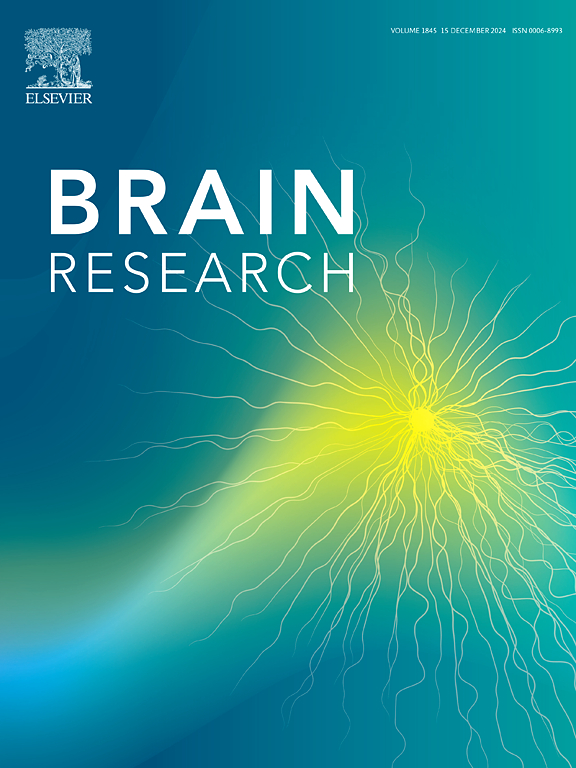IP-MS检测偏头痛大鼠ppid相互作用蛋白并进行生物信息学分析和实验验证
IF 2.6
4区 医学
Q3 NEUROSCIENCES
引用次数: 0
摘要
目的检测偏头痛大鼠三叉神经尾核(TNC)位点和肽基脯氨酸顺式反式异构酶D (PPID)相互作用蛋白,进一步探讨偏头痛发作的机制。方法建立两次注射硝酸甘油(NTG) (NTG-2)组和三次注射NTG (NTG-3)组,观察大鼠行为学、线粒体形态和PPID表达的变化。采集偏头痛大鼠TNC样本,采用免疫沉淀-质谱联用(IP-MS)分析PPID结合蛋白。并对相关通路进行了生物信息学分析。最后,通过蛋白对接和共免疫沉淀(Co-IP)实验对结果进行验证。结果偏头痛大鼠TNC部位PPID的表达随着注射次数的增加而上调。通过文献检索发现,与PPID结合并与偏头痛相关的蛋白主要有g蛋白偶联受体激酶相互作用蛋白2 (Git2)、Talin 1 (Tln1)、钠/钾转运atp酶亚基α -3 (Atp1a3)和蛋白酶激活受体2 (F2rl1)。蛋白对接结果均表现出良好的对接能力。Co-IP实验结果表明PPID和Atp1a3可以相互结合。结论ppid可能通过与Git2、Tln1、Atp1a3、F2rl1相互作用,通过线粒体-炎症途径参与偏头痛发作。本文章由计算机程序翻译,如有差异,请以英文原文为准。
Detection of PPID-interacting proteins in migraine rats by IP-MS and validation by bioinformatics analysis and experiments
Objective
This study was conducted to detect the trigeminal nucleus caudalis (TNC) site and Peptidyl-prolyl cis–trans isomerase D (PPID)-interacting proteins in migraine rats and further investigate the mechanisms involved in migraine attacks.
Methods
In this study, a two-time nitroglycerin (NTG) injection (NTG-2) group and a three-time NTG injection (NTG-3) group were established to observe the changes in behavior, mitochondria morphology, and PPID expression. Besides, the TNC samples of migraine rats were collected to analyze the proteins that can bind to PPID by immunoprecipitation combined with mass spectrometry (IP-MS). In addition, relevant pathways were analyzed by bioinformatics. Finally, the results were verified by protein docking and Co-immunoprecipitation (Co-IP) experiments.
Results
The results demonstrated that in the TNC site of migraine rats, PPID expression was up-regulated with an increase in the injection times of NTG. Through a literature retrieval, it was found that the proteins that bound to PPID and were related to migraine mainly comprised G-protein-coupled receptor kinase interacting proteins 2 (Git2), Talin 1 (Tln1), sodium/potassium-transporting ATPase subunit alpha-3 (Atp1a3), and proteinase-activated receptor 2 (F2rl1). The protein docking results all exhibited a good docking ability. The Co-IP experiment results revealed that PPID and Atp1a3 can bind to each other.
Conclusion
PPID can play a role in migraine attacks via the mitochondrial-inflammatory pathway by interacting with Git2, Tln1, Atp1a3, and F2rl1.
求助全文
通过发布文献求助,成功后即可免费获取论文全文。
去求助
来源期刊

Brain Research
医学-神经科学
CiteScore
5.90
自引率
3.40%
发文量
268
审稿时长
47 days
期刊介绍:
An international multidisciplinary journal devoted to fundamental research in the brain sciences.
Brain Research publishes papers reporting interdisciplinary investigations of nervous system structure and function that are of general interest to the international community of neuroscientists. As is evident from the journals name, its scope is broad, ranging from cellular and molecular studies through systems neuroscience, cognition and disease. Invited reviews are also published; suggestions for and inquiries about potential reviews are welcomed.
With the appearance of the final issue of the 2011 subscription, Vol. 67/1-2 (24 June 2011), Brain Research Reviews has ceased publication as a distinct journal separate from Brain Research. Review articles accepted for Brain Research are now published in that journal.
 求助内容:
求助内容: 应助结果提醒方式:
应助结果提醒方式:


